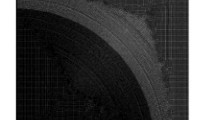Abstract
The plane strain dynamic singular stress problem for glassfiber reinforced plastics with a broken layer at low temperatures is considered. With the order of stress singularity around the tip of the crack which is normal to and ends at the interface between orthotropic elastic materials, Laplace and Fourier transforms are used to formulate the problem in terms of a singular integral equation. The singular integral equation is solved by using the Gauss-Jacobi integration formula. Numerical calculations are carried out, and the dynamic stress intensity factors at different temperatures are shown graphically.
Similar content being viewed by others
References
Dahlerup-Petersen, K. and Perrott, A. (1979). Properties of Organic Composite Materials at Cryogenic Temperatures, CERN ISR-BOM 79-39, Geneva, Switzerland.
Erdogan, F., Gupta, G.D. and Cook, T.S. (1972). Methods of Analysis and Solution of Crack Problems (Edited by G.C. Sih), Noordhoff, Leyden, 368.
Fabian, P.E., Schutz, J.B., Hazelton, C.S. and Reed, R.P. (1994). Properties of candidate ITER vacuum impregnation insulation systems. Advances in Cryogenic Engineering 40, 1007–1014.
Gupta, G.D. (1973). A layered composite with a broken laminate. International Journal of Solids and Structures 9 1141–1154.
Hashin, Z. (1972). Theory of Fiber Reinforced Materials, NASA-CR-1974, 1–194.
Humer, K., Tschegg, E.K. and Weber, H.W. (1994). Small specimens and new testing techniques for fiber reinforced plastics in the crack opening mode (mode I) and in the shear mode (mode II). Advances in Cryogenic Engineering 40, 999–1006.
Kasen, M.B., MacDonald, G.R., Beekman, D.H. and Schramm, R.E. (1980). Mechanical, electrical and thermal characterization of G-10CR and G-11CR glass/epoxy laminates between room temperature and 4K. Advances in Cryogenic Engineering 26, 235–244.
Kasen, M.B. and Schramm, R.E. (1982). Current status of standardized nonmetallic cryogenic laminates. Advances in Cryogenic Engineering 28, 271–277.
Kriz, R.D. (1985). Influence of damage on mechanical properties of woven composites at low temperatures. Journal of Composites Technology & Research 7, 55–58.
Kriz, R.D. (1989). Edge stresses in woven laminates at low temperatures. Composite Materials:Fatigue and Fracture 2, 150–161.
Kriz, R.D. and Muster, W.J. (1985).Mechanical-damage effects in woven laminates at low temperatures. Materials Studies for Magnetic Fusion Energy Applications at Low Temperatures-VIII NBISR 85-3025, 49–86.
Nozaki, H., Shindo, Y. and Atsumi, A. (1986). Impact response of a strip composite with a finite crack. Engineering Fracture Mechanics 23, 943–952.
Papoulis, A. (1957). A new method of inversion of the Laplace transform. Journal of Applied Mathematics 14, 405–414.
Sanada, K., Shindo, Y. and Ueda, S. (1998). Stress intensity factors for glass-fiber reinforced plastics with an infinite row of parallel cracks at low temperatures. Theoretical and Applied Fracture Mechanics 28, 183–196.
Simon, N.J., Drexler, E.S., and Reed, R.P. (1994). Compression and shear tests of vacuum-impregnated composites at cryogenic temperatures. Advances in Cryogenic Engineering 40, 977–983.
Ting, T.C. and Hoang, P.H. (1984). Singularities of the tip of a crack normal to the interface of a anisotropic layered composite. International Journal of Solids and Structures 20, 439–454.
Ueda, S. and Shindo, Y. (1991). Thermal singular stresses and mechanical properties in cracked glass-fiber reinforced plastics at low temperatures. Theoretical and Applied Mechanics 40, 249–257.
Ueda, S. and Shindo, Y. (1992). Glassfiber reinforced plastics with a T-shaped crack under tension at low temperatures. Theoretical and Applied Mechanics 41, 169–179.
Ueda, S., and Shindo, Y. (1993). Dynamic singular stresses in cracked glassfiber reinforced plastics at low temperatures. JSME International Journal, Series A 36, 367–373.
Ueda, S. and Shindo, Y. (1994). Singular stresses of glassfibre reinforced plastics with a broken layer at low temperatures. Materials Science and Engineering A176, 471–482.
Author information
Authors and Affiliations
Rights and permissions
About this article
Cite this article
Ueda, S. Dynamic singular stresses in glassfiber reinforced plastics with a broken layer at low temperatures. International Journal of Fracture 106, 13–31 (2000). https://doi.org/10.1023/A:1007636010830
Issue Date:
DOI: https://doi.org/10.1023/A:1007636010830




